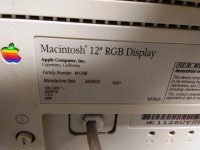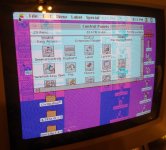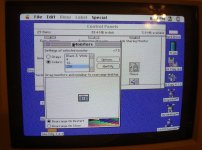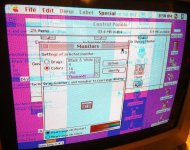Many questions have already been answered, as an original LC owner I want - in good old usenet style - to sum up some findings and add my own experiences:
1. Mac System 6 and 7 offer system specific installations especially for the LC, taking also care for its video circuitry. You should use these or probably the "universal Install" ("for all Macintoshes") settings of the Mac System Installer. The original LC (with MC68020) is compatible with versions 6.0.6 to 7.5.5.
2. The LC comes originally with one VRAM SIMM of 256kB in a single VRAM socket (next to the RAM sockets). This may be exchanged for a 512 kB VRAM SIMM (I did this in on my system in 1992).
3. With 256kB VRAM you get 256 colors/grays on Apple's 12 inch RGB Monitor, giving a screen resolution of 512 x 384 pixels, or 560 x 384 with the Apple II card (and with some system or monitor cdev versions, can't remember any more). You get 16 colors/grays with Apple's 13" High Resolution or Apple's later 14" displays, all at 640 x 480 pixels. Note, these are not VGA displays (different horizontal and vertical frequency). You get the same 640 x 480 pixels at 16 colors/grays on real VGA displays.
4. Original Apple Monitors are signaling their type by the so called "sense pins" in the display connector. If you are using a non-Apple monitor you need an adapter which usually includes dip switches, allowing you to configure the sense pins according to your needs. Note, that the later popular Multisync setting may likely not work with LC. You have to go for true VGA or simulating an Apple 13/14 inch (need to look up correct timing and sense pin-settings).
5. If you exchange the original 256 kB VRAM for a 512 kB one, you get "Thousands" of colors on the Apple 12" display and 256 colors/grays on 640 x 480 (both Apple 13/14" or real VGA). Everything about sense pin settings apply here as well.
Also: A analogue CRT monitor doesn't have an electrical limit in the numbers of colors it can display, it solely depends on the computer video hard- and software.
If your system software is correctly installed (preferably from a booted installer medium), and your video adapter/cable is correctly configured (you need to consult your adapter's configuration instructions or try through all possible settings) and you still have video issues the VRAM SIMM may be damaged.
More options for transferring software: If your source computer can handle 1.44 MB floppy disks (Mac or PC) you can use these on the LC too. To access DOS-formatted floppies (or even hard disks) comfortably you need a cdev from System 7.5 "PC Exchange", this may run also on 7.1 (not sure). For older Systems there was also the third party (Insignia Solutions or so) cdev "Access PC" which worked similar and probably even with System 6. However I have a faint memory of a system utility which shipped originally with "Super Drive" equipped Macs (1,44 MB types) which could be used too. To avoid problems with the resource fork of Mac software it is preferable to compress it with older versions of StuffIt or CompactPro (or encode the software to binhex-format). You need to unstuff/uncompress/unbinhex your compressed/encoded files on the LC.
Other transfer options are modem or network (even using ftp on a MacTCP-equipped LC - I had to fall back to this in University), but I don't want to discuss this in detail since this is already a very long post.
Games: You may want to look for newer versions of old Mac games. Old versions originally been written for 1-bit video on non-multifinder systems are often not compatible with newer video hardware, multi-color systems, Multi-Finder or System 7. (Re-) Releases from 1991 to 1993 may work most likely. Some games need 640x480 screens, some need 8-bit video (256 colors/grays), however many offer 4 bit (16 colors/grays) or even 1-bit (monochrome) versions.









